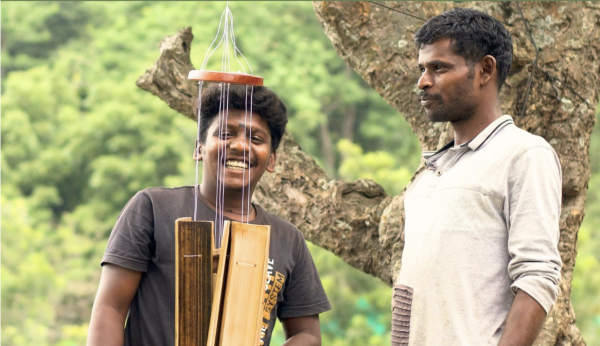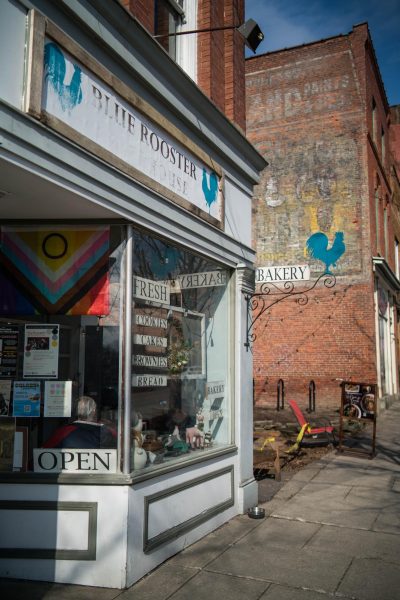CDS Serves Up Sweet Food Skills Lessons
As many college students know well, it can be difficult to cook for yourself while living in a dorm. This year, students can overcome this challenge by participating in Campus Dining Services’ series of informal classes and tastings. The primary purpose of these events isn’t to give intensive lessons or embark on especially challenging recipes — they’re meant to be a lighthearted, fun, delicious way to spend part of an afternoon learning about food.
DeCafé Unit Manager Daron Frederick taught the fourth class in the series, “Cooking with Chocolate,” Wednesday afternoon at the Rathskeller.
“We were looking for something fun to engage the students and to reach out and share our resources here at Oberlin with the student body,” Frederick said. “[This series is] something that’s just trying to engage and get the word out and interact with the student body and try to understand what they want and what people would like to learn how to do. We have a lot of knowledge in the kitchens, with all the different chefs that we have working here, and it just makes sense to pass some of that forward.”
The series comes in a set of six, and CDS intends to hold more in the future, College Campus Nutritionist Eric Pecherkiewicz said.
“We’ve covered Valentine’s Day treats, salsas and guacamole, and coffee tasting,” Pecherkiewicz said. “The last session is an overnight oats class in Kahn Hall’s first-floor lobby on Wednesday, April 11, at 5:30 p.m. We do plan to continue holding these in the [next] school year, but dates and subjects have not yet been determined.”
Wednesday’s tutorial began with a brief lesson on chocolate history and trivia, then moved into recipes. In a nod to the potential savory uses of chocolate, Frederick provided two recipes for molé sauces — a chocolate-based sauce typically used in Mexican cuisine. The rest of the class focused on desserts, including molded chocolates, dips, and microwave mug cakes.
“[Chocolate] is one of my main loves,” Frederick said. “I’ve always loved playing with chocolate, making chocolate, finding new recipes that you can make with chocolate. When we got the email earlier this year to discuss doing these cooking classes … [CDS] gave us a list of a lot of things that we could choose from. One of the things that was on there was cooking with chocolate, and I went right after it.”
Although chocolate is an extremely popular dessert, the class itself was poorly attended — two people attended, one of whom was College first-year Jeff Heo.
“It was very intriguing, actually,” Heo said. “I did know a little bit about chocolate, and making and molding chocolate, but doing it with the chef was a different experience. He told us a lot of information about how chocolate should be dealt with, and its history, and ways of using it. I think it was a very meaningful way to spend the middle of a Wednesday afternoon.”
With a big bowl of molten chocolate on the stove, Frederick began by demonstrating how to make a variety of molded chocolates. While carefully making sure not to let any steam seep over the edge of the bowl, which would cause the chocolate to seize and turn grainy, Frederick poured the chocolate into square molds, flower-shaped molds, and even one giant mold in the shape of an Easter bunny that was almost as large as an actual rabbit.
“Some of the molds that we used today I inherited from my grandmother from years and years ago,” Frederick said. “She had a very long passion for making chocolates and doing molds and stuff like that, so it’s something that I’ve done since I was a little kid. … I do it every year at my own home for Christmas presents, and sometimes around Easter as well. It’s just something that I’ve always enjoyed doing, and something that’s super easy that can be done in a microwave — it can be done with little to no prep and little to no experience with working with it. It’s just something that’s fun to do, and it’s delicious. I mean, who doesn’t like chocolate?”
Frederick then moved on to demonstrate how to make items dipped in chocolate, including strawberries, Oreos, pretzels, and potato chips. These desserts can easily be made in a dorm kitchen, using only a microwave and a fridge. Students can melt the chocolate in a microwave, taking it out in slow intervals to prevent it from burning, Frederick said, and it can work just as well as melting chocolate over the stove. Once things are dipped in chocolate, the treats only need to be refrigerated for about 20 minutes before they are ready to be enjoyed.
The tutorial ended with a lesson on how to make mug cakes, another simple recipe that requires only five minutes, minimal ingredients, and access to a microwave. Frederick said that to make a mug cake, melt two tablespoons of butter in a microwave-safe mug. Add a quarter-cup of cake mix, a tablespoon of milk, a teaspoon of vanilla extract, and one egg. Mix the ingredients together, then put the mug back in the microwave for one minute or until the cake is done. Because using the microwave cooks the egg very quickly, Frederick explained, mug cakes are safe to eat even when they’re not cooked through all the way, like a chocolate lava cake.
For Frederick, this semester’s series of classes may only be the start of a much more ambitious program, depending on how the student body responds to the continuing events in the series.
“I would love to see the word get out and have more people attend,” he said. “I would love to see it get to the point where we have to fill an entire classroom and maybe reserve a special space just for that class, and maybe even one day get it on the curriculum. I would love to see that.”
In Heo’s opinion, classes like this one can provide a real benefit to college students who don’t know much about cooking for themselves.
“This was a great program, and it was a very entertaining way to spend two hours of time,” Heo said. “I think it gives you a lot of experience on how to cook. For those people who don’t know the basics of cooking, this would be a really good introduction course.”







